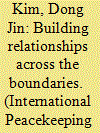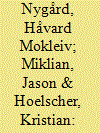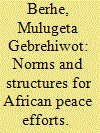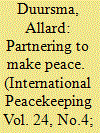|
|
|
Sort Order |
|
|
|
Items / Page
|
|
|
|
|
|
|
| Srl | Item |
| 1 |
ID:
153690


|
|
|
|
|
| Summary/Abstract |
The expectations for the role of civil society are growing due to an abysmal record of high-level political leadership in reaching an agreement and a sustainable peace process. How much impact can civil society have and what roles can it take in the peace process? This case study of South Korean civil society shows how the civil society was able to bridge the horizontal and vertical boundaries of the Korean conflict with the support of a global civil society, and created a hospitable public atmosphere for the peace process in the 1980s and 1990s. However, the space for the civil society to make a contribution in the Korean peace process required the interdependency of the roles of high-level and civil-society leadership in the interplay between the international and domestic political environments. The peacebuilding role of South Korean civil society demonstrates that the horizontal capacity of civil society alone cannot guarantee a breakthrough and sustainability in a peace process, but if it is coordinated with the vertical capacity, civil-society peacebuilding can be a useful platform for sustainable peacebuilding.
|
|
|
|
|
|
|
|
|
|
|
|
|
|
|
|
| 2 |
ID:
153691


|
|
|
|
|
| Summary/Abstract |
What factors explain attacks on humanitarian aid workers? Most research has tended to describe trends rather than analyse the underlying reasons behind attacks. To move this agenda forward, we present to our knowledge the first peer-reviewed cross-national time-series study that identifies factors related to violent attacks on humanitarian aid workers. Our theoretical framework explores two sets of potential explanatory factors: dynamics of conflicts; and the politicization and militarization of humanitarian operations. Using a global sample at the country level from 1997 to 2014, our results suggest that: (i) the presence and severity of armed conflicts are related to increased attacks on aid workers; (ii) aid workers do not appear to face greater risks even where civilians are targeted; (iii) the presence of an international military force does not appear to add to nor decrease risks to aid workers; and (iv) the effects of peacekeeping operations upon humanitarian security are varied. We discuss this in light of the ongoing challenges facing humanitarian organizations to provide security in fragile and conflict-affected areas.
|
|
|
|
|
|
|
|
|
|
|
|
|
|
|
|
| 3 |
ID:
153695


|
|
|
|
|
| Summary/Abstract |
The African Union (AU) norm relating to unconstitutional changes of government (UCG) distinguishes the African peace and security order from other regional and global peace and security orders. This norm assigns the regional organization an intrusive role unparalleled by other international organizations as far as the constitutional and democratic order of member states is concerned. The norm bans UCG and also provides for enforcement measures that received regional constitutional status in the founding treaty establishing the AU. Despite its emergence accompanying the democratization process that countries on the continent ventured into in the 1990s, seen in the light of Africa’s unhappy experience with illegal change or seizure of government, this norm cannot be dissociated from the continent’s concern about peace and security. Indeed, the norm’s defence of constitutional and democratic rule from unconstitutional changes has evolved and been utilized to operate as a means of promoting or securing stability and peace. Simultaneously, while the relatively consistent practice of enforcement of the norm that the AU developed over the years has served the objective of maintaining peace and security in Africa by playing key role in the decline of incidents of UCG, various challenges relating to its efficacy have been observed.
|
|
|
|
|
|
|
|
|
|
|
|
|
|
|
|
| 4 |
ID:
153696


|
|
|
|
|
| Summary/Abstract |
The African Peace and Security Architecture (APSA) is a set of norms and structures developed and designed to enable Africa with its peace and security affairs. It is an important instrument that enabled Africa gain significant success in its efforts to promote stability in Africa. The APSA was designed in the early 2000s and Africa needs to fully implement its norms and fully utilize its instruments. There is also a need to address gaps and redundancies so that it fits to the current context of new internal and global challenges.
|
|
|
|
|
|
|
|
|
|
|
|
|
|
|
|
| 5 |
ID:
153693


|
|
|
|
|
| Summary/Abstract |
This article systematically examines the varying effectiveness of African and non-African third parties in mediating civil wars in Africa. Drawing on data from the Uppsala Conflict Data Program, supplemented with unique data on mediation efforts, which together cover all mediation efforts in civil wars in Africa between 1960 and 2012, this article presents quantitative evidence supporting the effectiveness of African third parties. Compared to non-African third parties, African third parties are far more likely to conclude peace agreements and these peace agreements are more likely to be durable. Most effective, however, are mixed mediation efforts in which there is coordination between African and non-African third parties, but in which African third parties take the lead. The phrase, ‘African solutions to African challenges’ should thus be understood as a division of labour and responsibilities, rather than an excuse for non-African third parties to ignore Africa’s problems or African third parties acting on their own. Indeed, whilst African third parties should take the lead in mediation processes in African civil wars, non-African third parties should support these processes by lending additional strength. Through supplementing each other’s comparative advantages, African and non-African third parties can more effectively resolve civil wars in Africa.
|
|
|
|
|
|
|
|
|
|
|
|
|
|
|
|
| 6 |
ID:
153692


|
|
|
|
|
| Summary/Abstract |
Does the African Union (AU) have an anti-atrocities strategy, and if so, how would one recognize it and assess its impact? This paper proposes two manners of responding to these questions. In this first instance, we can analyse whether the AU has implemented an anti-atrocities agenda that resembles efforts elsewhere, notably at the United Nations. Another approach would be to examine what distinct strategies, strengths, and capacities that the AU brings to the work of reducing threats of mass violence against civilians. This second approach reveals how the AU has innovated a politics of protection. Assessing the AU as both implementer and innovator of protection suggests a more complex picture of the organization’s strengths and weaknesses than assessing either role alone, and reveals that overemphasizing the importation of an agenda developed elsewhere may ultimately undermine the organization’s core capacities.
|
|
|
|
|
|
|
|
|
|
|
|
|
|
|
|
| 7 |
ID:
153694


|
|
|
|
|
| Summary/Abstract |
This article considers the military doctrine currently available to the African Standby Force (ASF) for peace operations (PO) on the African continent. In the absence of an updated and relevant doctrine for PO, risks are posed to the harmonization and coordination of multinational missions, as well as to the successful achievement of mission objectives. Despite laudable efforts by both the United Nations (UN) and bilateral donor nations to support the preparatory and continuation training of ASF troops, differences in the national and multinational experiences of this work and the differences in the legal basis of this doctrine do not provide an optimal ‘stop gap’ measure. The pressing new requirement for African peace missions to deter terrorist and insurgent anti-peace factions exposes the limitations of UN doctrine, which preserves traditional peacekeeping principles of consent, impartiality and minimum use of force. UN peace enforcement mandates, and guidance derived from NATO’s non-African experiences do not provide adequate guidance for ASF troops preparing to enter these operating environments. A cursory study of the impact of the absence of common doctrine supporting the multinational African Union Mission in Somalia (AMISOM) indicates that different doctrinal approaches impact negatively on AMISOM’s ability to achieve its objectives.
|
|
|
|
|
|
|
|
|
|
|
|
|
|
|
|
|
|
|
|
|